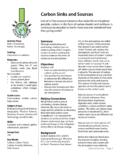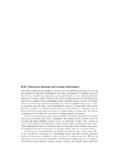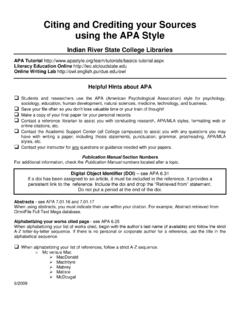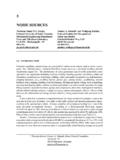Transcription of OSWER Technical Guide for Assessing and …
1 OSWER Publication OSWER Technical Guide FOR Assessing AND MITIGATING THE VAPOR INTRUSION PATHWAY FROM SUBSURFACE VAPOR SOURCES TO INDOOR AIR U. S. Environmental Protection Agency Office of Solid Waste and Emergency Response June 2015 June 201 5 Assessing and Mitigating the Vapor Intrusion Pathway from Sub surface Vapor Sources to Indoor Air DISCLAIMER This document presents current Technical recommendations of the Environmental Protection Agency (EPA) based on our current understanding of vapor intrusion into indoor air from subsurface vapor sources. This guidance document does not impose any requirements or obligations on the EPA, the states or tribal governments, or the regulated community. Rather, the sources of authority and requirements for addressing subsurface vapor intrusion are the relevant statutes and regulations.
2 Decisions regarding a particular situation should be made based upon statutory and regulatory authority. EPA decision-makers retain the discretion to adopt or approve approaches on a case-by-case basis that differ from this guidance document, where appropriate, as long as the administrative record supporting its decision provides an adequate basis and reasoned explanation for doing so. i June 201 5 Assessing and Mitigating the Vapor Intrusion Pathway from Sub surface Vapor Sources to Indoor Air TABLE OF CONTENTS DISCLAIM i TAB LE OF CONTENTS .. ii LIST OF vi LIST OF TABLE S .. vi LIST OF vii ACRONYM S AND ABBREVIATIONS .. viii INTRODUCTION .. 1 Definition of Vapor 1 Statutory Authorities .. 3 Taking Action with Limited Data under CERCLA and the NCP.
3 4 Taking Action with Limited Data under RCRA Corrective Action .. 6 Scope and Recommended Uses of this Technical 6 Petroleum Hydrocarbons .. 9 Nonresidential Buildings .. 10 Companion Documents and Technical Resources .. 10 Vapor Intrusion Screening Level 11 Technical Support Documents .. 11 Historical Context .. 12 Public Involvement in Developing Vapor Intrusion Technical Guide .. 16 16 CONCEPTUAL M ODEL OF VAPOR 19 Subsurface Vapor Sources .. 22 Subsurface Vapor 24 Openings and Driving Forces for Soil Gas Entry into Buildings .. 26 Air Exchange and Mixing .. 30 Conceptual Model Scenarios .. 31 Variability in Exposure Levels .. 34 Consideration of Indoor and Outdoor Sources of VOCs .. 34 OVERVIEW OF VAPOR INTRUSION Technical 36 Contaminants of Potential Concern.
4 36 ii June 201 5 Assessing and Mitigating the Vapor Intrusion Pathway from Sub surface Vapor Sources to Indoor Air Vapor Intrusion Assessment .. 37 Building Mitigation and Subsurface Remediation .. 41 Community Outreach and Involvement .. 44 CONSIDERATIONS FOR NONRESIDENTIAL BUILDINGS .. 46 PRELIM INARY ANALYSIS OF VAPOR INTRUSION .. 49 Assemble, Evaluate, and Review Available Information .. 49 Identify and Respond to Conditions that Warrant Prompt Action .. 51 Determine Presence of Structures and Vapor-forming Chemicals .. 52 Develop Initial Conceptual Site Model .. 55 Evaluating Pre-Existing and Readily Ascertainable Sampling Data .. 58 Evaluate Sampling Data Reliability and Quality .. 58 Evaluate Applicability of the VISLs and Adequacy of the Initial 59 Preliminary Risk-based Screening.
5 59 DETAILED INVESTIGATION OF VAPOR INTRUSION .. 61 Common Vapor Intrusion 61 Planning and 63 Vapor Intrusion Inclusion 67 Prioritizing Investigations with Multiple Buildings .. 69 Planning for Community 71 Characterize the Vapor Intrusion Pathway .. 71 Characterize Nature and Extent of Subsurface Vapor Sources .. 72 Characterize Vapor Migration in the Vadose Zone .. 75 Assess Building Susceptibility to Soil Gas Entry .. 78 Evaluate Presence and Concentration of Subsurface Contaminants in Indoor Air .. 80 Identify and Evaluate Contributions from Indoor and Ambient Air Sources . 81 Select, Prioritize, and Sequence Investigation 86 General Principles and Recommendations for Sampling .. 87 Indoor Air 88 Outdoor Air Sampling.
6 98 Sub-slab Soil Gas Sampling .. 99 Soil Gas 103 Groundwater 104 iii June 201 5 Assessing and Mitigating the Vapor Intrusion Pathway from Sub surface Vapor Sources to Indoor Air Planning for Building and Property 105 Overview of Risk-Based Screening .. 105 Objectives of 105 Scope and Basis for Health-based, Vapor Intrusion Screening Levels .. 106 Recommended Attenuation Factors for Health-based Screening .. 108 Comparing Sample Concentrations to Health-based Screening Levels .. 111 Planning for Communication of Sampling Results .. 112 General Principles and Recommendations for Mathematical Modeling .. 113 RISK ASSESSM ENT AND M ANAGEM ENT FRAM EWORK .. 117 Collect Site-specific Lines of Evidence .. 117 Weigh and Assess Concordance Among the Lines of 120 Evaluate Whether the Vapor Intrusion Pathway is Complete or Incomplete.
7 122 Conduct and Interpret Human Health Risk 124 Risk Management Benchmarks .. 127 Accounting for Background Contributions .. 128 Occupational Exposure Limits .. 128 Concentration Levels Indicating Potential Need for Prompt Response 129 Potential Explosion Hazards .. 129 Considering Short-term and Acute 129 Risk-based Cleanup Levels .. 131 Options for Response Action .. 132 Pre-emptive Mitigation/Early 134 Rationale .. 135 General Decision Framework .. 136 Some General Scenarios Where Pre-emptive Mitigation May be Warranted .. 137 Additional Considerations .. 141 BUILDING M ITIGATION AND SUBSURFACE REM 143 Subsurface Remediation for Vapor Source 143 Building Mitigation for Vapor Intrusion .. 144 Prompt Response Options for Existing 144 Active Depressurization Technologies for Existing 147 Approaches and Considerations for New Buildings.
8 150 Owner/Occupant Preferences and Building 151 iv June 201 5 Assessing and Mitigating the Vapor Intrusion Pathway from Sub surface Vapor Sources to Indoor Air Operation and Maintenance of Vapor Intrusion Mitigation Systems .. 151 Monitoring of Vapor Intrusion Mitigation Systems .. 153 Documentation of Engineered Exposure Controls for Vapor Intrusion 156 Use of Institutional Controls .. 157 Evaluating ICs in the Overall Context of Response Selection .. 158 Common Considerations and Scenarios Involving ICs .. 159 Selecting the Right Instrument(s) .. 163 Long-term Stewardship .. 165 Community Involvement and ICs .. 166 Termination/Exit 167 Termination of Subsurface Remediation Activities .. 167 Termination of Building Mitigation.
9 168 Termination of ICs .. 170 Termination of Monitoring .. 170 PLANNING FOR COMMUNITY INVOLVEM 175 Developing a Community Involvement or Public Participation Plan .. 177 Communication Strategies and Conducting Community Outreach .. 179 Addressing Building Access for Sampling and Mitigation .. 182 Communication of Indoor Sampling Efforts and Results .. 183 Transmitting Messages Regarding Mitigation Systems .. 185 Addressing Community Involvement at Legacy 186 Property Value Concerns for Current and Prospective Property Owners .. 187 Additional Community Involvement Resources .. 187 GLOSSARY .. 189 CITATIONS AND REFERENCES .. 202 APPENDIX A Re commended Subsurface-to-Indoor Air Attenuation Factors ..A-1 APPENDIX B Data Quality Assurance B-1 APPENDIX C Calculating Vapo r Source Concentration from Groundwater Data.
10 C-1 v June 201 5 Assessing and Mitigating the Vapor Intrusion Pathway from Sub surface Vapor Sources to Indoor Air LIST OF FIGURES Figure 2-1 Illustration of Key Elements of the Conceptual Model of Soil Vapor Intrusion Figure 2-2 Illustration of Potential Openings in Various Building Types Figure 2-3 Some Factors That Affect Vapor Intrusion Figure 3-1 Overview of Recommended Framework for Vapor Intrusion Assessment and Response Action Figure 6-1 Overview of Planning, Scoping, and Conducting Vapor Intrusion Investigations Figure 7-1 Sample Depiction of Subsurface Vapor Source and Data to Support Pre-emptive Mitigation/Early Action for Multiple Buildings, Each with Limited Data Figure 7-2 Sample Depiction of Subsurface Vapor Source and Data to Support Pre-emptive Mitigation/Early Action for Multiple Buildings, Some with Only Limited or No Data Figure 8-1 Illustration of Sub-slab Depressurization (SSD) System Figure 8-2 Illustration of Drain-tile Depressurization (DTD) System Figure 8-3 Illustration of Block-wall Depressurization (BWD) System Figure 8-4 Illustration of Sub-membrane Depressurization (SMD) System LIST OF TABLES Table 1-1 Directory to Updates in This Technical Guide Addressing Recommendations of EPA Office of Inspector General (EPA 2009) Table 1-2 Directory to Additional Updates in This Technical Guide Publicly Identified by OSWER (EPA 2010A)

















